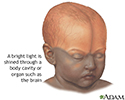Transillumination
Transillumination is the shining of a light through a body area or organ to check for abnormalities.
How the Test is Performed
The room lights are dimmed or turned off so that the area of the body may be seen more easily. A bright light is then pointed at that area. Areas where this test is used include the:
- Head
-
Scrotum
Scrotum
The scrotum is a part of a male's body that is located behind the penis. The scrotum is the sac (pouch) that contains the testes, epididymis, and th...
 ImageRead Article Now Book Mark Article
ImageRead Article Now Book Mark Article - Chest of a premature or newborn infant
- Breast of an adult female
Transillumination is also sometimes used to find blood vessels.
In some locations in the stomach and intestine, the light can be seen through the skin and tissues at the time of upper endoscopy and colonoscopy .
Upper endoscopy
Esophagogastroduodenoscopy (EGD) is a test to examine the lining of the esophagus, stomach, and first part of the small intestine.

Colonoscopy
A colonoscopy is an exam that views the inside of the colon (large intestine) and rectum, using a tool called a colonoscope. The colonoscope has a sm...

How to Prepare for the Test
No preparation is necessary for this test.
How the Test will Feel
There is no discomfort with this test.
Why the Test is Performed
This test may be done along with other tests to diagnose:
-
Hydrocephalus
in newborns or infants
Hydrocephalus
Hydrocephalus is a buildup of fluid inside the skull that leads to brain swelling. Hydrocephalus means "water on the brain. "
 ImageRead Article Now Book Mark Article
ImageRead Article Now Book Mark Article -
Hydrocele
in males
Hydrocele
A hydrocele is a fluid-filled sac in the scrotum.
 ImageRead Article Now Book Mark Article
ImageRead Article Now Book Mark Article - Breast lesions or cysts in females
In newborns, a bright halogen light may be used to transilluminate the chest cavity if there are signs of a collapsed lung or air around the heart. (Transillumination through the chest is only possible on small newborns.)
In general, transillumination is not an accurate enough test to rely on. Further tests, such as an x-ray, CT, or ultrasound, are needed to confirm the diagnosis.
Normal Results
Normal findings depend on the area being evaluated and the normal tissue of that area.
What Abnormal Results Mean
Areas filled with abnormal air or fluid light up when they should not. For example, in a darkened room, the head of a newborn with possible hydrocephalus will light up when this procedure is done.
When done on the breast:
- Internal areas will be dark to black if there is a lesion and bleeding has occurred (because blood does not transilluminate).
-
Benign
tumors tend to appear red.
Benign
"Benign" refers to a condition, tumor, or growth that is not cancerous. This means that it does not spread to other parts of the body. It does not ...
 ImageRead Article Now Book Mark Article
ImageRead Article Now Book Mark Article - Malignant tumors are brown to black.
Risks
There are no risks associated with this test.
References
Ferri FF. Hydrocele. In: Ferri FF, ed. Ferri's Clinical Advisor 2016 . Philadelphia, PA: Elsevier Mosby; 2016:647.
Katz VL, Dotters D. Breast diseases: diagnosis and treatment of benign and malignant disease. In: Lentz GM, Lobo RA, Gershenson DM, Katz VL, eds. Comprehensive Gynecology . 6th ed. Philadelphia, PA: Elsevier Mosby; 2012:chap 15.
Lissauer T. Physical examination of the newborn. In: Martin RJ, Fanaroff AA, Walsh MC. Fanaroff and Martin's Neonatal-Perinatal Medicine Diseases of the Fetus and Infant . 10th ed. Philadelphia, PA: Elsevier Saunders; 2015:chap 29.
-
Infant brain test - illustration
Transillumination is the shining of a bright light through a body cavity or organ for diagnostic purposes. Transilllumination can be used on the head, scrotum, or chest in the premature or newborn infant, or the breast in an adult female.
Infant brain test
illustration
-
Infant brain test - illustration
Transillumination is the shining of a bright light through a body cavity or organ for diagnostic purposes. Transilllumination can be used on the head, scrotum, or chest in the premature or newborn infant, or the breast in an adult female.
Infant brain test
illustration
Review Date: 8/14/2015
Reviewed By: Subodh K. Lal, MD, gastroenterologist at Gastrointestinal Specialists of Georgia, Austell, GA. Review provided by VeriMed Healthcare Network. Also reviewed by David Zieve, MD, MHA, Isla Ogilvie, PhD, and the A.D.A.M. Editorial team.

